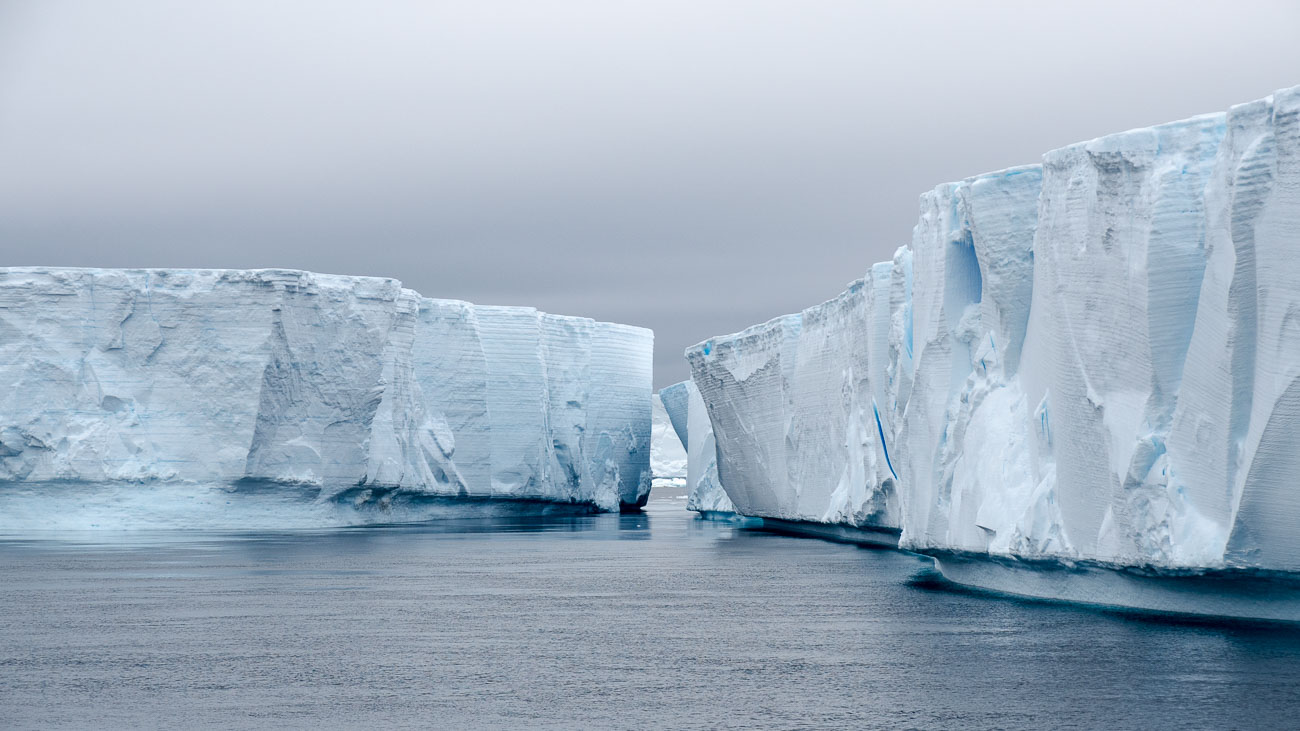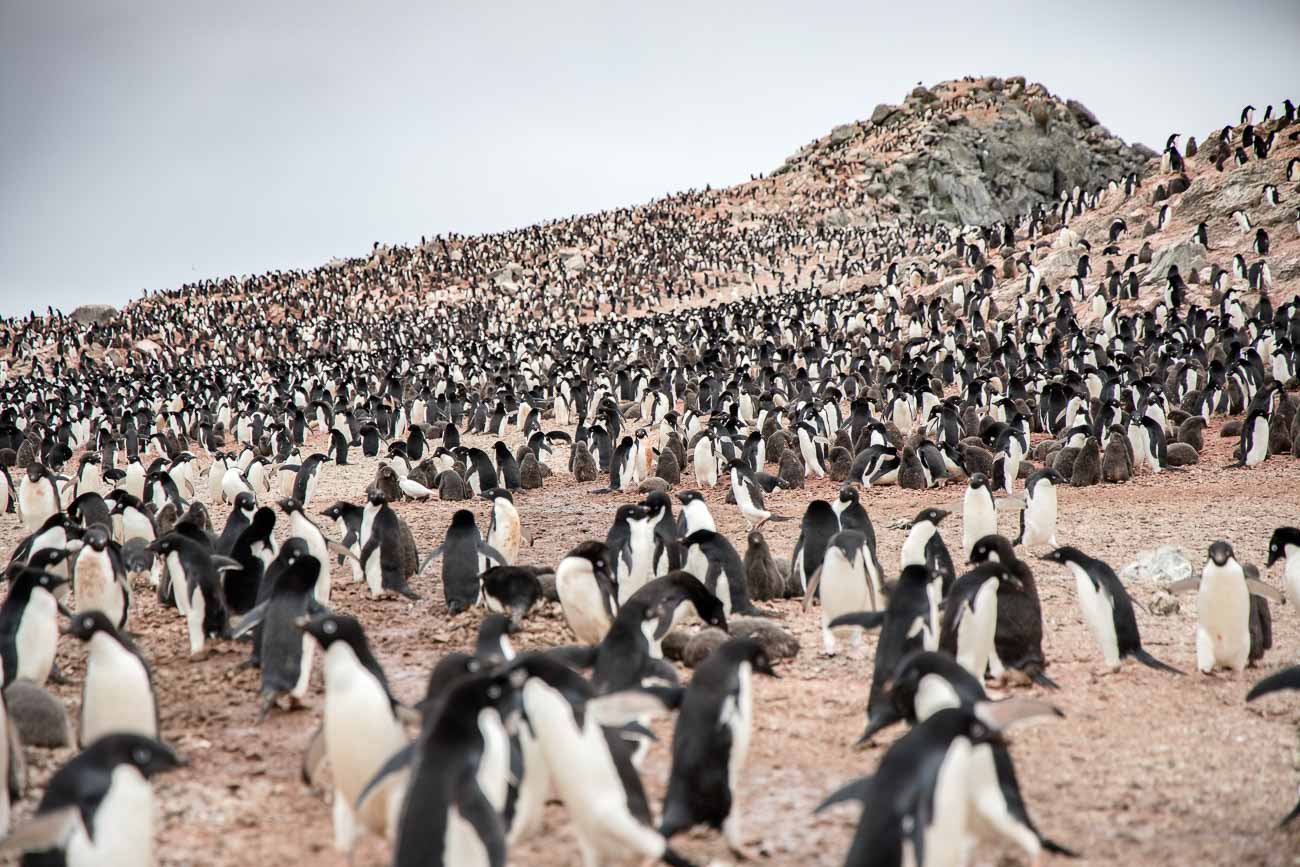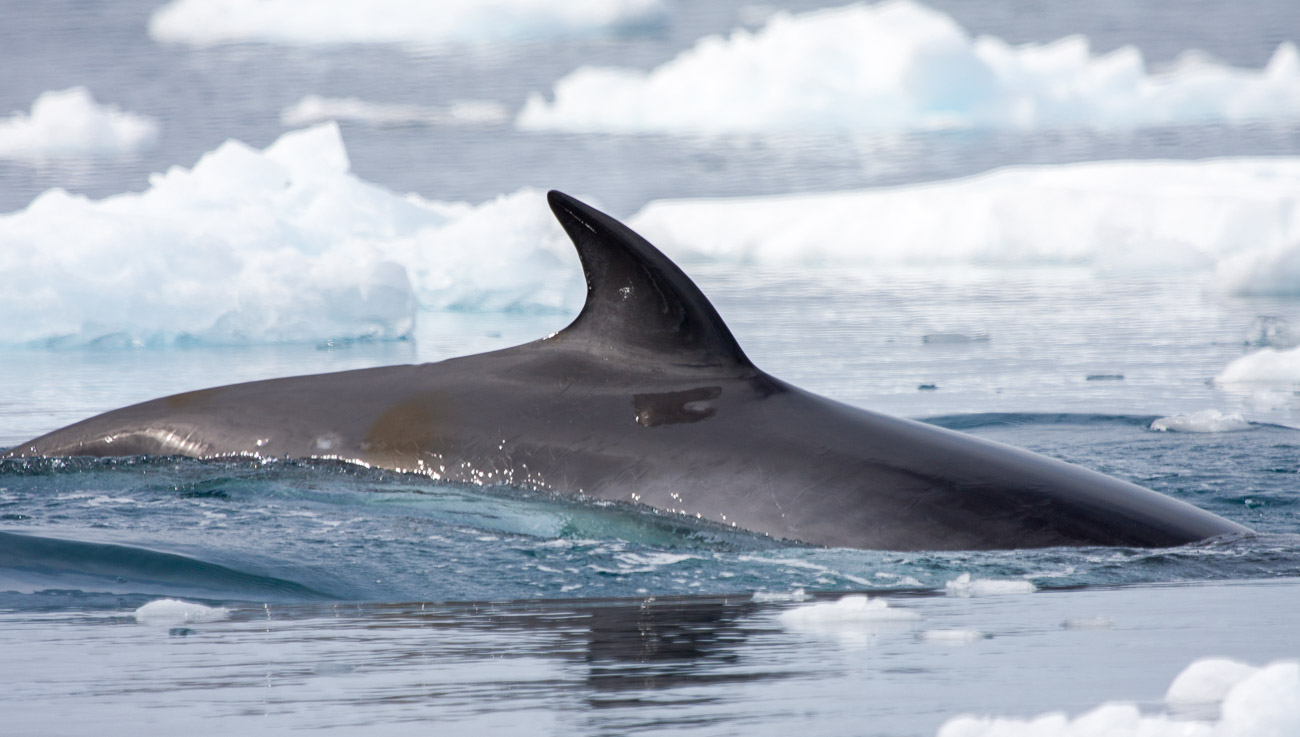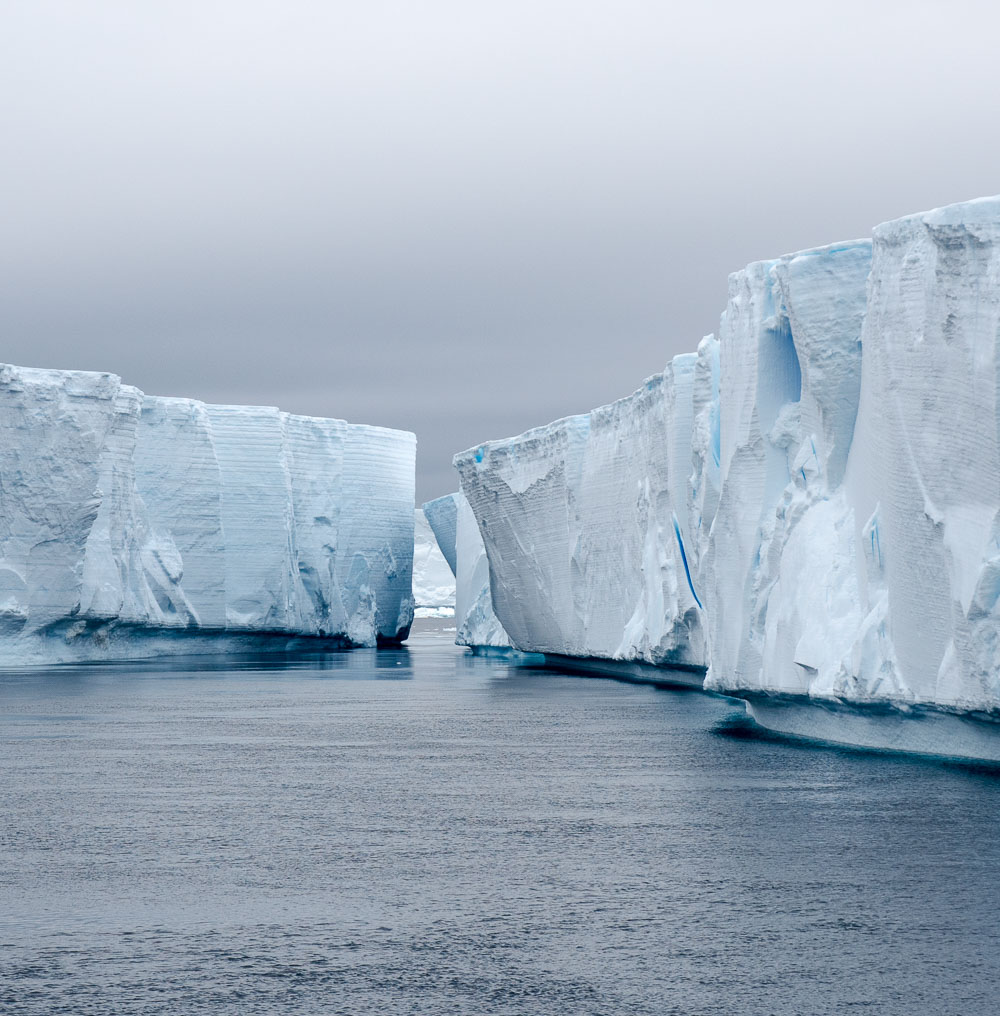
DISCOVERING THE ANTARCTIC PENINSULA
DISCOVERING THE ANTARCTIC PENINSULA
DISCOVERING THE ANTARCTIC PENINSULA
DISCOVERING THE ANTARCTIC PENINSULA
Why visit the antarctic peninsula ?
The best way to describe the Antarctic peninsula is very simple: think of them as the "Alps" (or your favorite mountain range) that end directly in the ocean.
The Antarctic continent is not only the last discovered continent, but also the least inhabited (there are no “natives” or “locals” and no permanent population). Therefore, it is a unique place to experience the pristine, wild environments of the polar regions, as almost no trace of contemporary existence or past human presence can block your view. Landscapes have not changed since the first human beings set their eyes on Antarctica. You will discover the same views that the early explorers saw for the very first time.
Naturally, the wildlife is amazing and encounters with penguins, seals and whales will make your trip even more memorable!
However, what I have noticed most while traveling in the Antarctic, is that the “world of ice” is what is enjoyed above all else! You cannot compare the Antarctic peninsula with any other place on Earth. Endless fields of glaciers, steep snow-covered mountains coming down to the sea, icebergs of all sizes, drifting ice floes and fast ice. This is truly something remarkable and unforgettable.
Last, but certainly not least, the human history of the Antarctic peninsula is very rich. The peninsula is the closest part of Antarctica to any civilization (South America). Therefore, many expeditions, explorers and discoverers have cast off from South America. Nowadays, you can visit remains of the whaling time, remains of expeditions from the heroic age of exploration, visit scientific huts from the 50’s, and even modern stations.
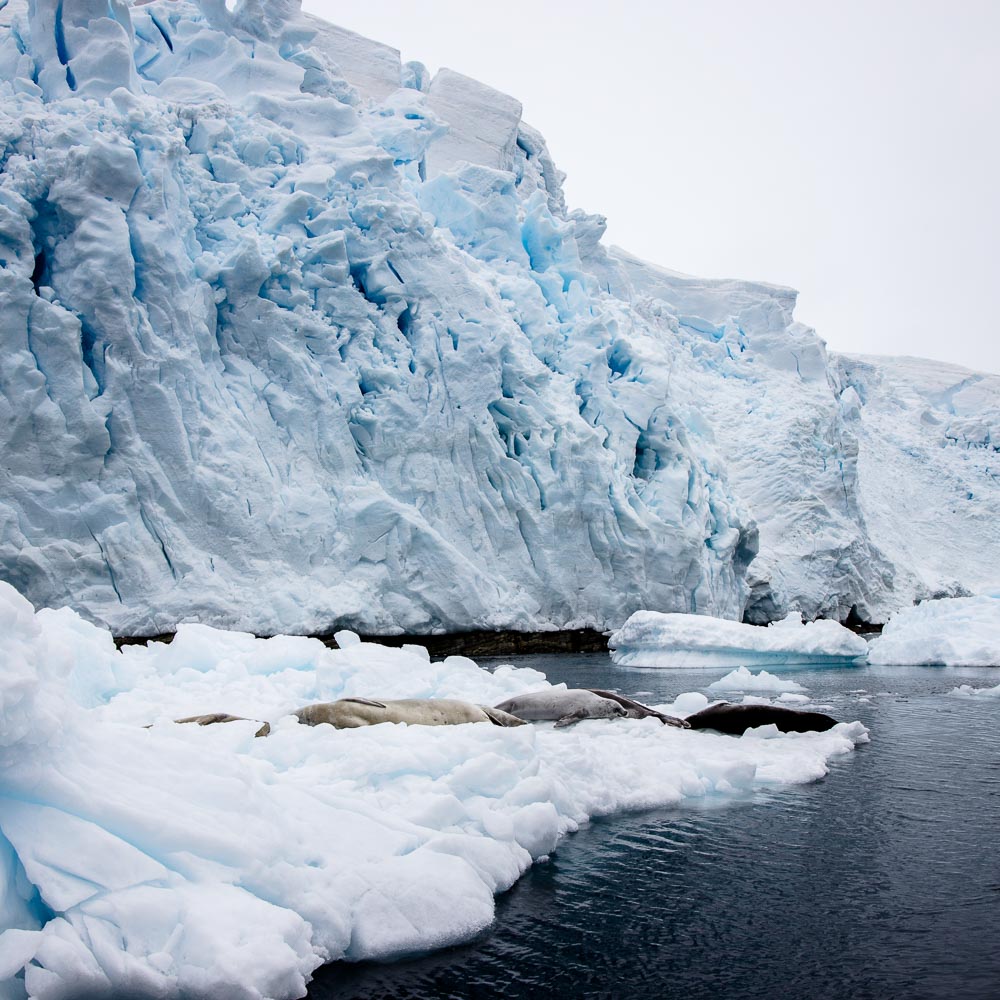
Crabeater seals resting on an ice floe in the Lemaire channel, Antarctic peninsula
What can you see?
Wildlife
With the exception of one or two invertebrates, there are no land animals in Antarctica!
Penguins
The polar regions are arid. So, naturally, the variety of animals is quite low. But some of them are present in large numbers, like penguins!
As penguins are seabirds, they nest every year at the exact same place. So, if their nesting site is ice free and weather conditions allow, we can guarantee a visit to the rookery. The most common penguin species to see around the Antarctic peninsula is also the least abundant throughout the white continent: the Gentoo penguin.
You can visit a few colonies of Chinstrap penguins who nest a bit higher in latitude, mostly around the South Shetlands, (Coronation islands and other remote sub Antarctic islands) although you can find a few nests here and there in the Gerlache strait.
The Adelie penguin is another species of penguin that you can observe in the Antarctic. This species of penguin is the most representative of Antarctica, and one of only two species that breed solely in Antarctica. Their rookeries are located mostly quite far South (South of the Lemaire channel), or in the Antarctic Sound or the Weddell sea.
Regarding Emperor penguins, I’m afraid that you will be unlikely to see this big bird first-hand. They are so rare to see in the summer time, that should you encounter just one Emperor penguin, even if it is a juvenile, it will make your entire trip! Visiting the remote, nearly inaccessible site of an Emperor penguin colony is only possible at the very start of summer, and incredibly few trips (mostly by air) can bring you to the right place.
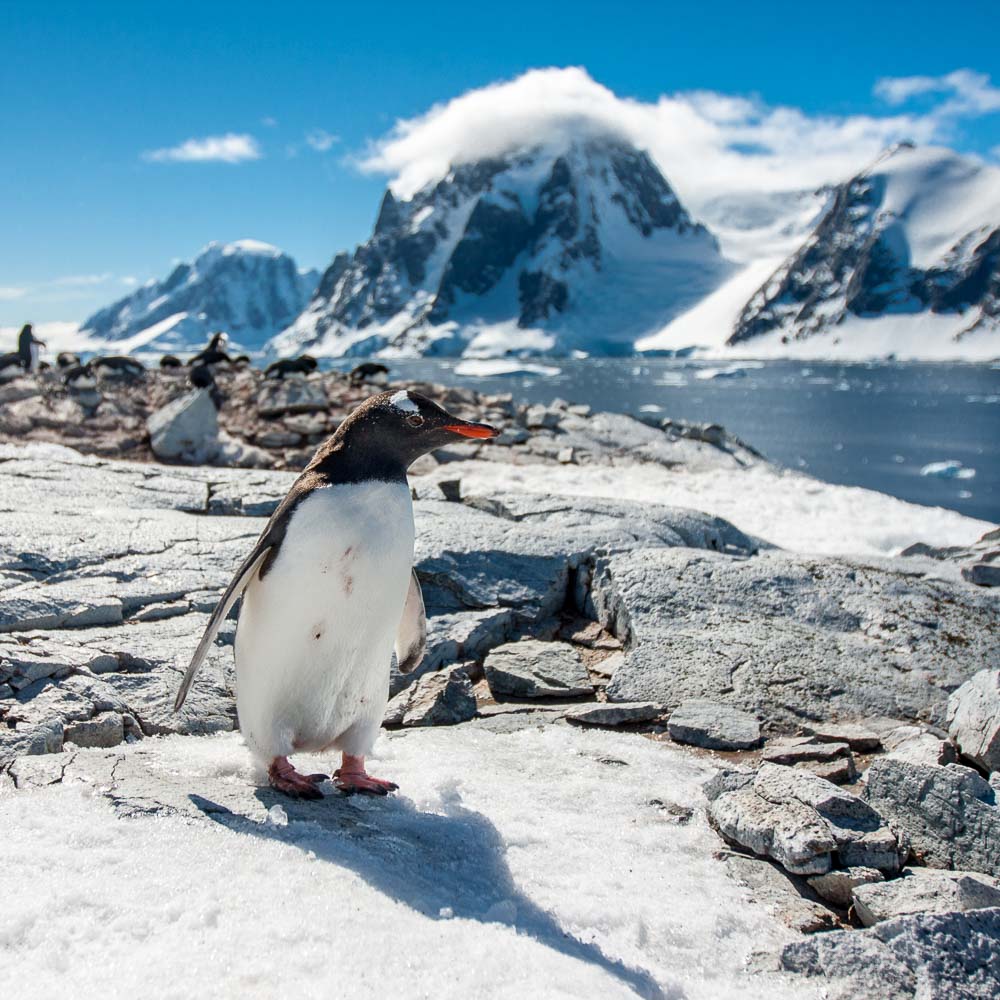
Gentoo penguin at Petermann island, Antarctic peninsula
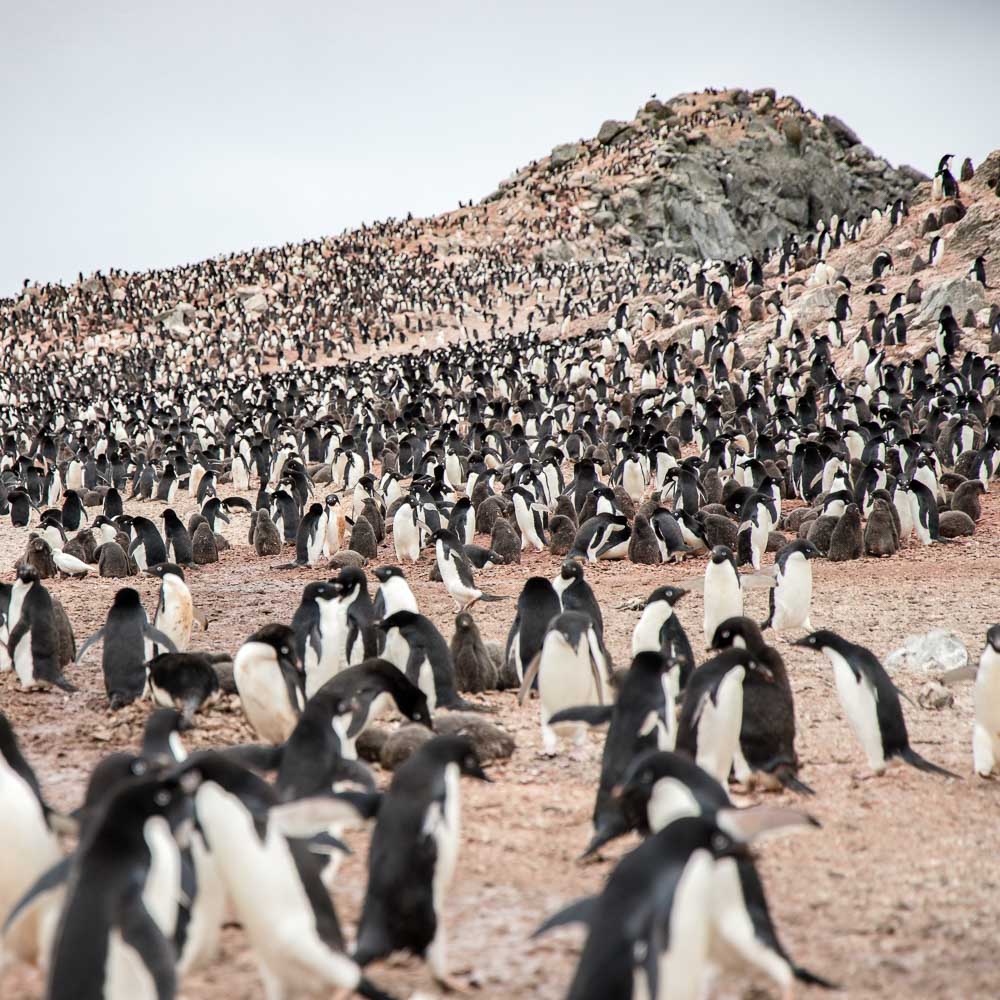
Hundreds of thousands of Adelie penguins on the Danger islands, Antarctic peninsula
Seals
You can see a few species of seals around the Antarctic peninsula: crabeater seals, which are the most abundant; Weddell seals, that are also common to see and a great deal bigger; Leopard seals, that are much less common but huge and an impressive predator; and the very rare and least common of all: The Ross seal. This species is solitary and has been observed only a few times. Sometimes, on the rare occasion, you can also observe Elephant seals and Antarctic fur seals, depending on where you are and the time of the year. The density of seals and the number of encounters is unpredictable as true seals (crabeater, Weddell, Leopard and Ross seals) live in the vicinity of the sea ice. Antarctic fur seals have been wiped out from the Antarctic peninsula and the few that you do glimpse here, come from South Georgia and hang around the peninsula after the breeding season. There are very few colonies of Elephant seals that breed in the South Shetlands and may travel sporadically further South.
Whales
The most common whale to see are Humpback whales. You may also see some Minke whales, which are much smaller and faster; Orcas, also called killer whales are present in that area too. Away from coastal waters, you might observe bigger whales such as: Fin whales, Sei whales, or the rare blue whale. The encounter of these cetaceans is based mostly on patience, observation, and luck!
Flying birds
It is common to observe albatrosses, prions and petrels Southbound or Northbound through the Drake passage. Once around the Antarctic peninsula, you will no longer see any albatrosses. The petrel family, however, will be highly present with different species like Cape petrel, Giant petrel and Wilson storm petrel. You’ll also find the main predator of penguin eggs: the Skua. One species of cormorant, tern, and sheathbill.
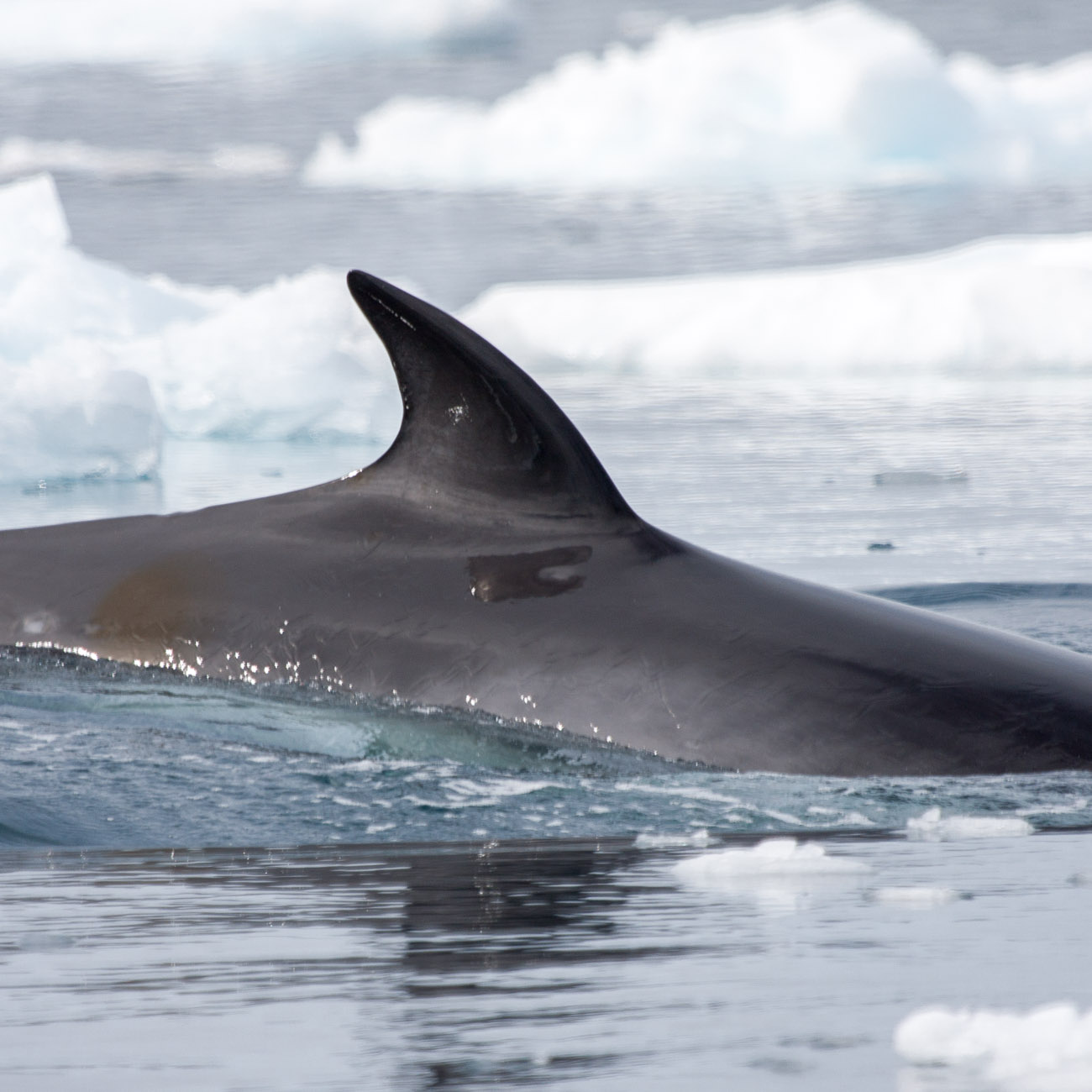
Close-up of the dorsal fin of an Antarctic Minke whale at Cierva cove, Antarctic peninsula
Ice
I won’t go into detail about all the different kinds of ice you can find in nature, but you'll certainly see a lot around the Antarctic peninsula! As a reminder, 90% of the glacier ice on our globe is in Antarctica! Glaciers cover the mountain chain of the peninsula as well as all the islands around. Glaciers end in the sea, so you will see icebergs of all sizes: brash, bergy bit, growler and maybe some gigantic tabular icebergs. You will also see a range of sea ice, with ice floes of all sizes, from a few square feet to a few square miles, as well as fast ice and multiyear sea ice!
The world of ice is waiting for you!
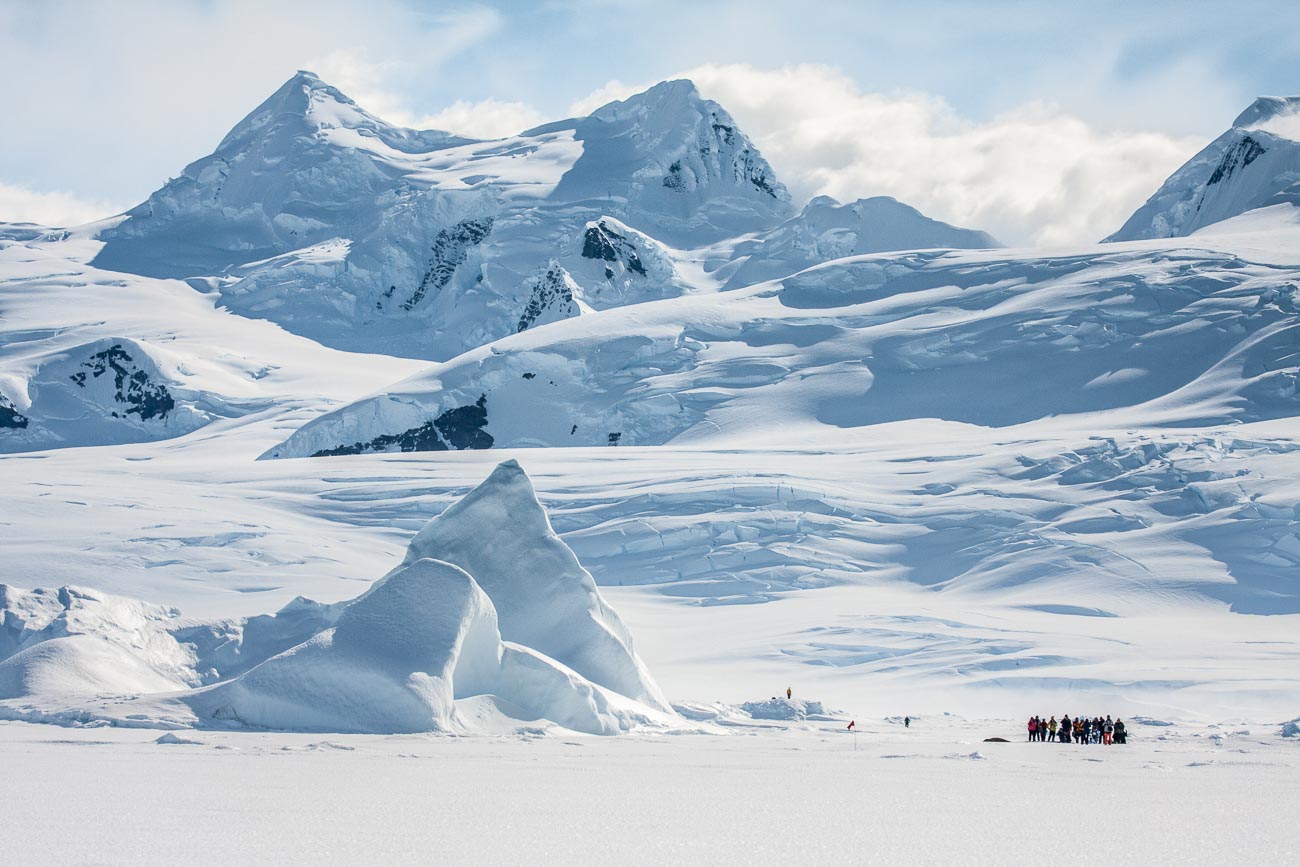
A group of tourists walking on the fast ice in Lallemand bay, watching a seal, surrounded by a grounded iceberg with glaciers in the background
Human history
Whaling remains
At present, signs of humans in Antarctica are very subtle. Nothing that compares to Rome! A few rusty things here, stones or pieces of wood there, maybe a hut. But, what a thrill to know the story of the people who dared to venture here in much less comfortable circumstances! Of course, the most common relics come from the whaling time: metal chains, pots, boilers, water boats, oil tanks, living quarters... All of these artifacts date to around the late XVIIIth, XIXth and XXth century.
Scientific remains
Dedicated for piece and science, Antarctica attracted the scientific community in mass during the 3rd International Polar Year in 1957. Today we can visit scientific huts that still stand and are well conserved.
Remains of polar exploration
This is my favorite part! When you read about these extraordinary adventures, to be at the exact spot where all of these stories happened and to see with your own eyes the leftovers of polar pioneers gives me goose bumps!
Modern scientific stations
This is not very common, but occasionally, a visit to a contemporary and active place of research is possible. You should consider yourself very fortunate if this does happen during your trip, as it is a real privilege to see what the crew from these stations offer you.
Buildings for political claim
Unfortunately, Antarctica is the heart of many political claims. You can see visible traces of these commitments: for example, all the flags you'll see around the buildings!
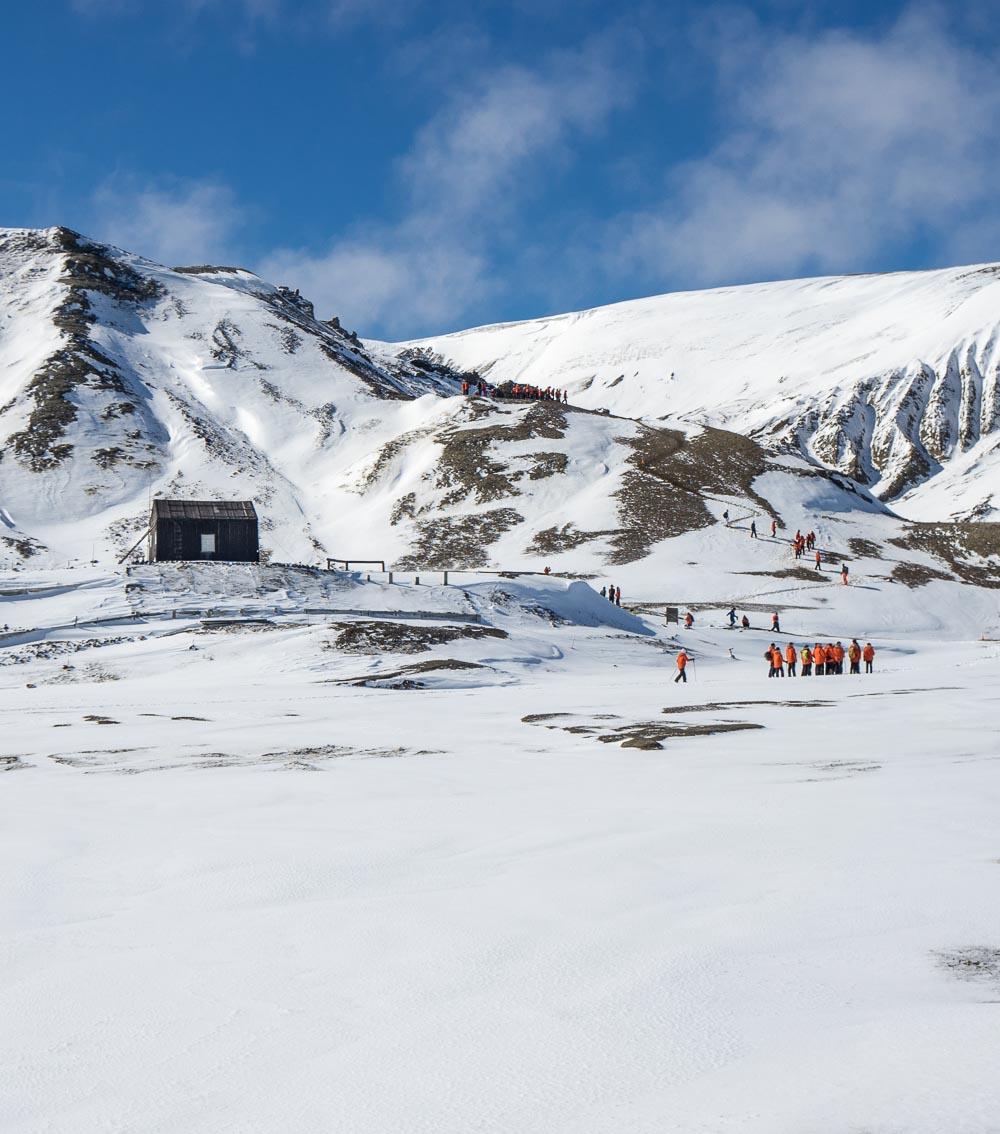
The historical hut at Snow hill island in the Weddell sea, from the Swedish Antarctic Expediton led by Otto Nordenskjöld (1901-1904)
What is the best time to visit Antarctica ?
This is a very common question.
Some years ago, the season for visitors to discover Antarctica by ship was short. Nowadays, seasons are getting longer as the number of travelers is rising and companies want to increase their profit.
Though it is possible to visit the Antarctic peninsula from late October till early April, I prefer giving you the following recommendations:
October
I do not like going to the Antarctic peninsula “too early”. That means October till early/mid-November. At this time of the year, it is the end of winter and summer is only about to start. It is more likely that you will still experience a lot of bad weather, wind, cold days, snow… And you still have a lot of sea ice, which makes navigation really tricky, and more sites are difficult to access.
From end of November until end of December
Personally, this is my favorite part of the season. The weather is normally much better than in October; you’ll find snow everywhere; and the whole coastline looks pristinely white. The penguins are nesting, rookeries are well defined. You still have a lot of sea ice, and it might be the best moment of the season to get an opportunity to walk on it!
January
This is also a very good time to visit the Antarctic peninsula. The penguin eggs have hatched around Christmas and there is more agitation around the colonies. The chicks, and different scenes of regurgitation, feeding, etc. are always very appreciated by the passengers. The weather is usually the best you can expect during the whole season. As it is the peak of summer time, there is less and less sea ice, day after day, which make many sites accessible to visitors. As permanent daylight helps navigation at night, it is possible to go and explore places that are not often visited, and allows more options to play with sudden changes of weather. Whales also start their migration around this time, and the number of sightings increase.
February
We are approaching the minimum sea ice extension which is in March. A lot of remote places are now ice free. So, it is possible to explore more, but nights once again become darker and might slow down navigation at night, which does not help when it comes to navigating around iceberg and the sea ice. A lot of snow will have melted and the beaches are mostly rocky, snow free, and full of… penguin guano! The penguin rookeries are very smelly and the penguin chicks are already quite big. They spread out around the rookeries and offer little space for visitor to walk. For these reasons, the end of the season and late February is not my favorite. However, when penguins start fledging at the end of February, they go to sea for their first baths! It’s a thrill to watch leopard seals hunting them. It is also a time where there are more humpback whales in the area.
March
Beûrkkk. I really do not like this time of the year. It is too dark to safely navigate during the night, so covering long distances can be problematic. The weather is definitely worsening as summer comes to an end, and some penguin colonies are empty as they are gone for the winter. All the penguin rookeries are muddy and covered with tons of guano. However, as the days become shorter, the colors in the sky at sunset are really fantastic. If you are a fan of photography, this can be the ideal time for landscape shots. There are also some humpbacks whales still around.
April
To my knowledge only one company still operates in early April. There are no more penguin rookeries to visit as all the penguins have left the area; the nights are longer than the days; so these trips focus mostly on landscape photography and whale sighting.
Any doubts, questions, or more informations?
Contact mePlease find below a few books and a map that I recommend you read before your departure. They will give you a good idea of the history of the area and some key stories that happened around the places you may visit There are also two guide books about wildlife (including one which is very dense with information), which I consider to be incredibly informative if you like to study animals in the wild!
as an Amazon associate I earn from qualifying purchases
Map
Antarctic explorer map

This is an excellent foldout map of Antarctica. On one side there is a map of the Antarctic continent, around which succinct biographies of Antarctic explorers from William Spiers Bruce to Edward Wilson are shown. On the other side there are many fine colour photographs of seals, penguins and other Antarctic wildlife, together with an inset box summarizing the Antarctic Treaty and other information on Antarctic waters, Cape Horn, Tierra del Fuego, the Beagle Channel, the Falkland Islands and South Georgia. It is aimed at visitors arriving by sea.
Book
Antarctic wildlife: a visitor's guide

by James Lowen.
A very good guidebook that helps you identifying, understanding and learning about the the wildlife of the Antarctic Peninsula, Drake Passage, and Beagle Channel. Which means the area you're traveling during a journey by ship to the antarctic peninsula.
Book
Antarctica: or, two years amongst the ice of the south pole

By Otto Nordenskjöld.
A must to read. The relation by the expedition leader himself of what was one of the most extraordinary adventure around the Antarctic peninsula from 1901 to 1904.
This is the narrative of the Swedish South Polar Expedition by the geologist and expedition leader of the expedition Otto Nordenskjöld who wintered at Snow Hill Island on the East side of the Antarctic peninsula. The expedition ship the “Antarctic”, captained by Carl Anton Larsen, was crushed in the ice and its crew wintered at Paulet Island, while a third other wintered at Hope Bay at in the Antarctic sound. Without knowing where each party was, they all met “by chance” two years after the start of the adventure at Cape Well met in the Weddell sea. This is a remarkable adventure starting with a disaster and finishing with a happy end.
Book
Through the first Antarctic night

By Frederick Albert Cook.
Frederick Cook, American physician and polar explorer, gives a detailed account of his experiences on the Belgian Antarctic Expedition, the first to endure the harsh winter of the Antarctic (1899).
This story happens around the antarctic peninsula, where a strait has been named after the Belgian vessel: the Belgica, led by Adrien De Gerlache. A lot of place names of that area have been named during this expedition.
The goal was scientific discovery, and Cook, the ship's doctor, tells an engaging story of 'new human experience in a new, inhuman world of ice'. Boarding the Belgica in Rio de Janeiro, he joined a crew that included Roald Amundsen, who would later lead a Norwegian expedition to the South Pole.
Cook describes the challenging conditions in the Antarctic Circle, where the ship became ice-bound for almost a year, with over two months of total darkness. When crew members developed scurvy, notably, he helped save lives by promoting the consumption of penguin and seal meat at a time when Vitamin C had yet to be discovered.
Book
The complete guide to Antarctic wildlife
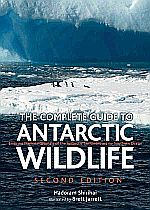
By Hadoram shirihai
Alula Press editions
This guide deals with the identification, biology and distribution of the fauna of the Antarctic and subantarctic area and also presents the main archipelagos and continental sectors (geology, inventoried species, numbers, conservation).
The quality and richness of the information is clear and accessible. The different parts are well structured, the photos of excellent quality and the illustrations worthy of the best naturalist guides. The amount of data and criteria available is impressive. Complete, superbly illustrated, dense and up-to-date, it is the essential work for anyone interested in polar fauna. A must-have that has proven itself.
